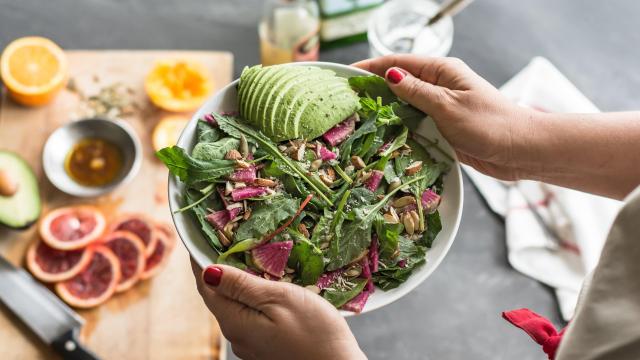I get produce paralysis. Despite the world of salads being so incredibly diverse, somehow I’ll make the same one week after week, even if I’m bored of it. But after flipping through an old salad cookbook listing ingredients with no measurements, I remembered that recipes ain’t the boss of me. You can create a whole fresh take on your salad, even with the same old ingredients. Keep your go-to salads interesting by simply changing up the ratios.
Altering the amounts of each ingredient is a simple way to solve the annoying problem of food boredom because it’s low risk. It’s almost a sure thing you’re going to like the salad since you’ve enjoyed a similar combination before. It saves you time and frustration. You don’t have to pour over new recipes online, looking for the next perfect salad for you to wear out. Plus, being flexible with your salad ratios can save the day when you inevitably come home and realise you don’t have “enough” baby spinach. Turns out you have the perfect amount because today, spinach is just a garnish.
Most salads are a collection of components nestled together or tossed, but the pieces don’t rely on each other in a mechanical sense like with other meals. While achieving balanced flavour with your ingredients is key, it’s not the same as, say, a lasagna where the ratio of ingredients can affect the construction. Salads are ripe for fiddling with. Start with shifting around the big players. Most salads consist of a few primary components, secondary ones, and a dressing or dip. Let’s focus on the solid ingredients before we bring in the dressings. Maybe you make a killer spring greens salad, and the bulk is built of leafy greens, tossed with halved baby potatoes, a few strips of chicken, cucumbers, and a sprinkle of feta. You have extra ingredients for the next salad night, but you don’t have to make the same salad twice in a row. Bulk the chicken and feta next time, so that becomes your base, and decrease the amount of greens and potatoes. Now it’s a chicken feta salad. Or try a singular switch and make the foundation cucumber-heavy while keeping the other ingredients the same. Behold, a crisp cucumber salad. A simple adjustment like this can completely transform your worn out salad recipe even with the same ingredient list.
Dressings are another way to take a new salad a bit further. While I don’t recommend making the dressing the highest ratio in your salad, you can (and should) play with your sauce. If you’re making your own dressing, view it as its own little world of ratios. Try bumping up the measure of the acid, or decreasing the sweet component. Some salads use yogurt, hummus, or another type of dip or spread as the flavorful coating. These can sit on the fence between a primary component and dressing. If I increase the hummus measurement to bulk-status, I usually pair it with an equal-ratio partner ingredient, to keep it from being overwhelming or weighing the salad down. Any of these ratio adjustments will spin your salads in a new direction. Try one switch at a time, or try them all at once, and never wear out your salads again.

Leave a Reply
You must be logged in to post a comment.